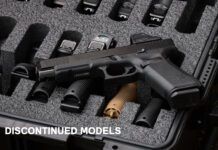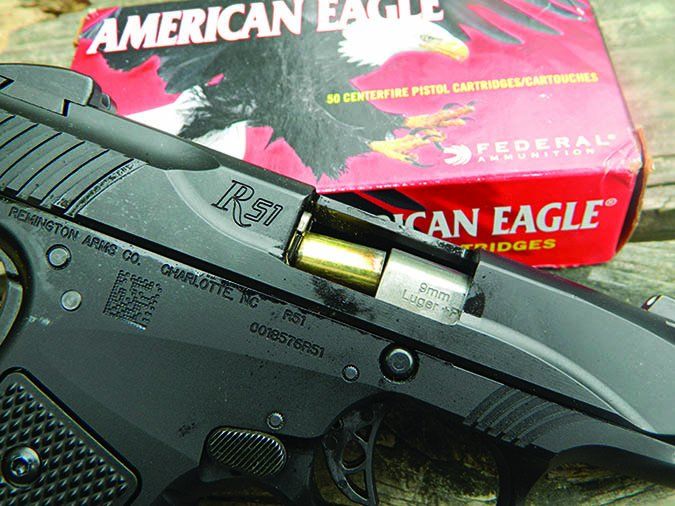
We recently tested four single-stack 9mm Luger defense-oriented handguns, among the most popular carry guns in America. Three were single-action pistols and one was a double-action-only model. The spread in expense was pronounced, from less than $200 to more than $700. As always, when we’re evaluating carry pistols, handling and accuracy mean a lot, but reliability is the bottom line, and we start with a pistol that has had a mark beside its name for being unreliable. In the lineup was a pistol taking its second bite at the apple, Remington’s R51 96430 9mm Luger, which has undergone a recall and revamp and is now back on dealer shelves. Pitted against it were a SIG Sauer P938 Engraved Rosewood Micro-Compact 938-9-ESR, a Taurus 709 Slim 1-709031FS, and a Kel-Tec PF-9.
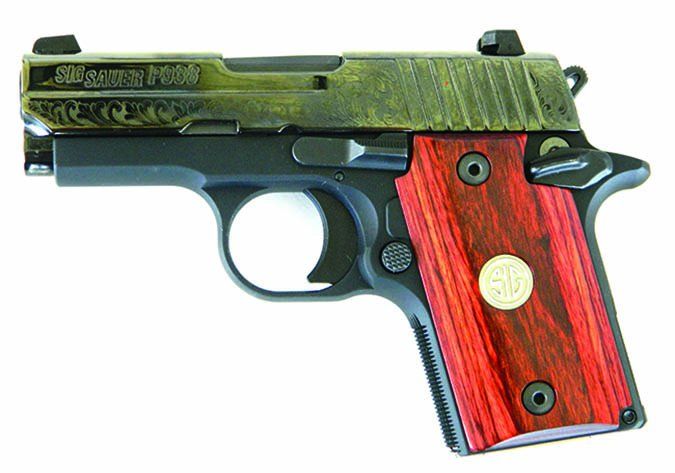
All of these handguns have a history with us. Most recently, the R51 did well in its initial test in our pages, but was recalled shortly thereafter. In the August 2014 issue, we said, “The Remington R51 was a handy, comfortable pistol of just the right size for its power. Felt recoil with the hottest ammo was amazingly light, and muzzle flip was almost non-existent. It had an odd takedown procedure that was easily mastered. The gun had enough accuracy for its intended purpose. It worked well, was not too expensive, had a great trigger and great sights, and we really liked the concept.
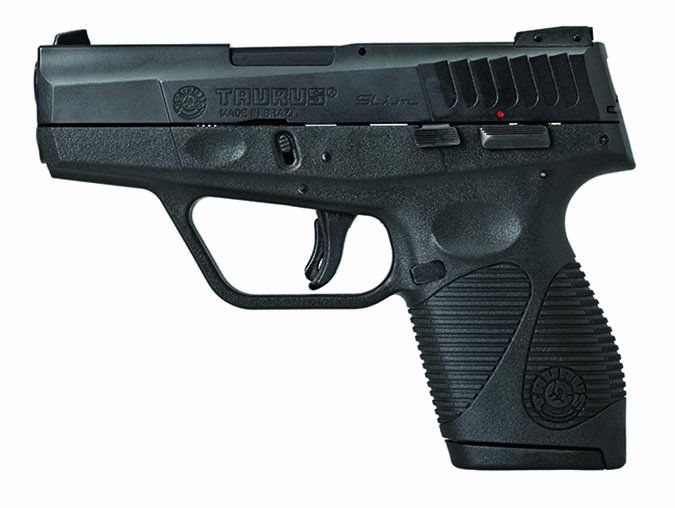
“Though our FFL advised us that other shooters were having function problems with the R51, our test gun simply did not exhibit those problems. Because we only report what happens in our tests and base our grades on our own experiences, we could not fault the R51 for issues other people were having.
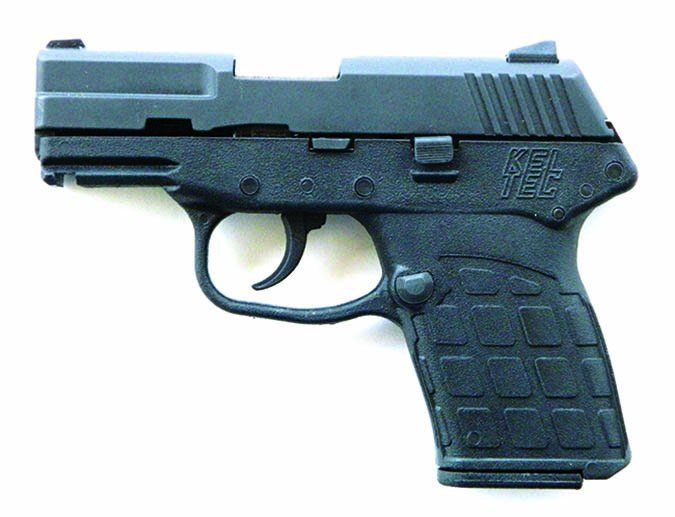
“However, after publication of the August print issue, we learned that the R51 had been recalled by Remington. We adjusted the grade on the R51 to an F and returned our test gun to the factory under the recall program.”
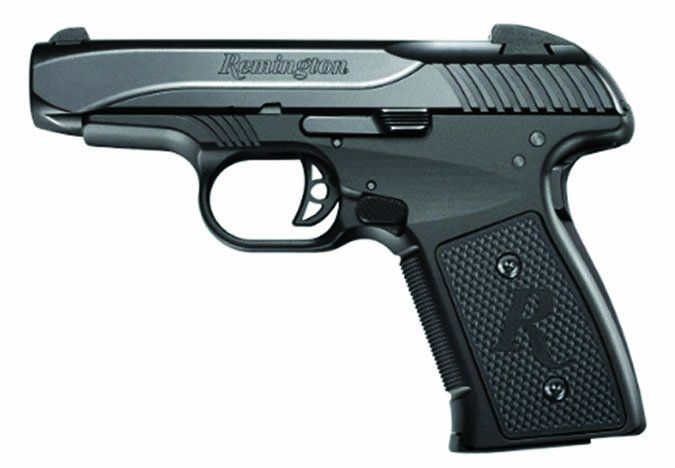
Then, late last year, Remington Arms Company announced that the R51 had returned to the market with enhancements that included updated slide internals, precision-engineered extractor, locking snag-free sights, tuned recoil spring, hard-chromed barrel bushing, a single-action trigger, and two semi-flush 7+1 round magazines. At the time of the re-release, Remington said the pistol had been extensively tested. The company again touted the R51’s features and benefits, including a lightweight aluminum frame with rounded edges for comfortable conceal carry, a grip safety, low bore axis for reduced recoil/muzzle flip, a concealed carry trigger that was a light, crisp single action, low slide racking-force for ease of manipulation, an ambidextrous magazine release, locking drift-adjustable sights, and optimized grip angle. Our test gun, a full replacement of the original, has a suggested retail price of $448.
The last time we looked at the Kel-Tec PF-9 9mm was in April 2011. Of the PF-9, we said, “All business-like flat black, the blued Kel-Tec PF-9 is slim and easily concealable. It was a bit too big for most trouser pockets, but would fit most overcoat pockets. The fixed sights gave an excellent picture that we thought could be improved by widening the rear notch. There were three white dots. The rear sight was adjustable for windage, and by shimming for elevation. An Allen screw secured it. Both the front and rear sights were polymer, as was the trigger and, of course, most of the frame.
“The integral grips had a coarse checkerboard pattern that provided excellent traction, and the front and rear grip straps had vertical serrations. The magazine release was a steel button that was not easy to hit accidentally, but let the mag come out easily when intentionally pressed. The gun could be fired with the magazine removed.
“In our testing we came to love the trigger of the Kel-Tec. We had no trouble whatsoever with short-stroking the trigger in rapid shooting. In fact, the recoil seemed to blow the gun backwards and our trigger finger forward. We were unaware of the trigger needing to be carefully allowed to go all the way forward. We essentially had no problems at all with the Kel-Tec PF-9. We had one failure for the slide to lock back on empty with the first magazine-full through it, but that never happened again. We think this is one mighty fine 9mm handgun, but it is not for the recoil-sensitive person.”
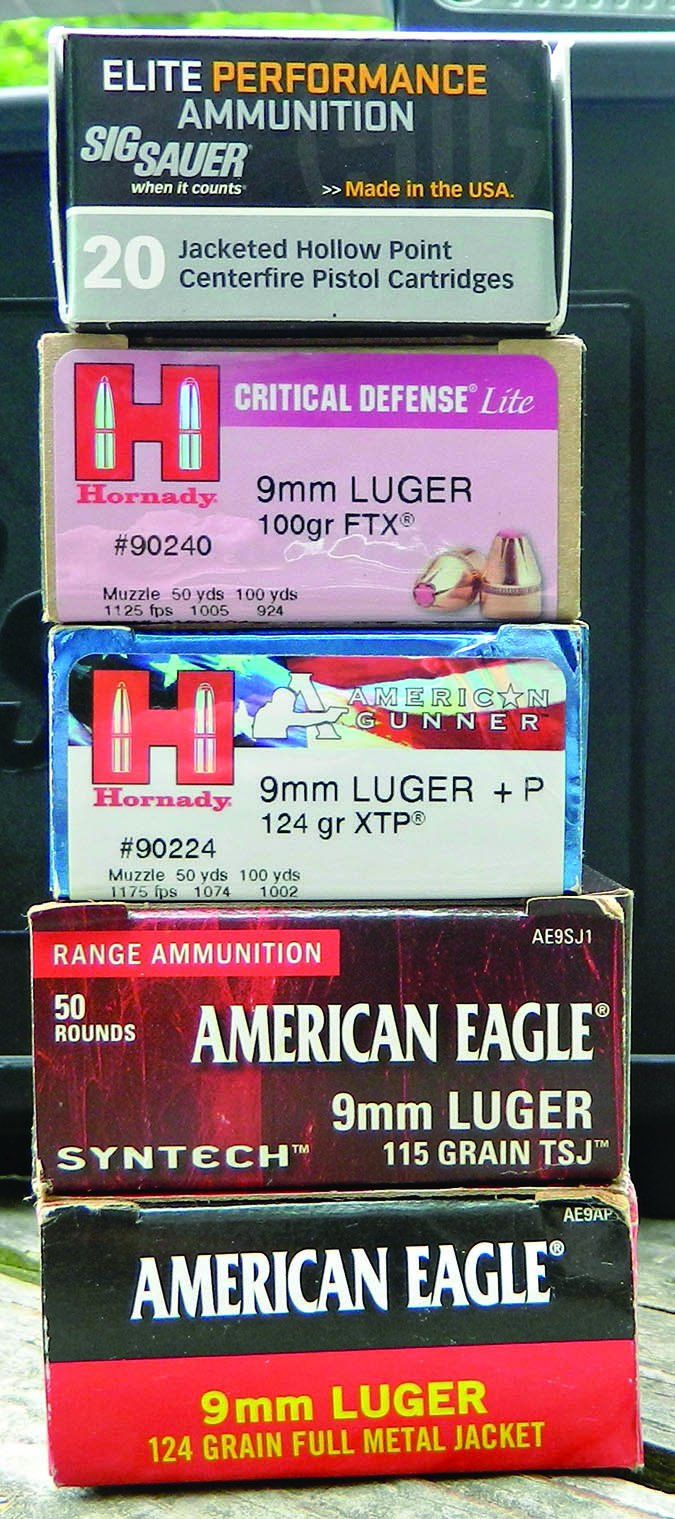
About a year later (March 2012),we test-fired the Taurus 709B Slim No. 1-709031. Back then, we said of the handgun, “We never suffered a failure to ignite or any other type of malfunction, so all shots in our tests were performed using the single-action trigger. From the 10-yard bench, only two groups measured 2 inches wide or larger. Overall average size for all groups fired in our tests computed to about 1.5 inches.
“We found the Taurus 709B to be controllable, so even the hottest EXP rounds were not tiring to shoot. Due to its small size, we actually preferred shooting the 709B held in one hand. This could be a plus, in our view, because when fighting in close quarters the support-side hand might be busy wrestling with an assailant.
“Our Team Said: The 709B performed quite well. We did notice discoloration on ejected brass that told us the barrel was unlocking prematurely and allowing gas to blow rearward into the chamber. But suitable velocities for each round were recorded, and the 709B was one of the least tiring or abusive little nines we’ve tried.”
And we’ve had a lot of asks from readers to look at SIG’s P938 again, because the first time, the handgun didn’t do so well: An “F” grade in the March 2013 issue. That model was the SIG Sauer P938 Extreme No. 938-9-XTM-BLKGRY-AMBI. It was plagued by malfunctions, we reported: “Our initial test firing made us think we’d found the ideal small nine. Everything was great, we thought. And then the nightmare began. On our next familiarization shooting with a few dozen rounds, we had a handful of failures to fire. Inspection showed the primers were essentially untouched. One or two had the tiniest mark of the firing pin. Some rounds failed to fire from repeated strikes of the hammer. Along with the failures to fire, we had occasional failures to completely eject. Commonly the last cartridge case from the magazine would get caught and mangled on its way out.
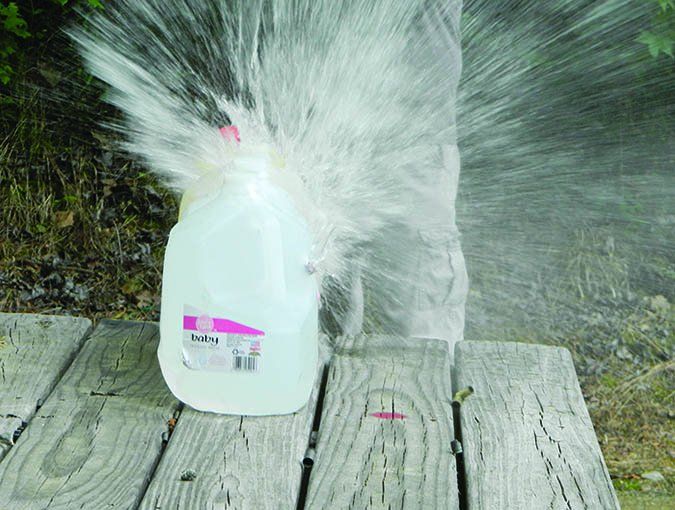
“Inspection revealed a broken extractor. It was such a clean break we couldn’t be sure at first, but comparison with other extractors indicated there should have been more meat on this one. SIG overnighted us a new extractor. The part is investment cast, lightly machined, and has a small stress relief in the form of a fillet along one side of the chunk that broke off. It doesn’t have a fillet behind the hook. We didn’t like the design, but it’s common in today’s handguns. If the extractor had been milled from a forging and heat-treated properly, it would most likely never break in a thousand years.”
Range Data
| Federal American Eagle 124-gr. Full Metal Jacket AE9AP | Kel-Tec PF-9 | Taurus 709 Slim | Remington R51 | SIG Sauer P938 |
| Average Velocity | 1014 fps | 1062 fps | 1057 fps | 990 fps |
| Muzzle Energy | 283 ft.-lbs. | 310 ft.-lbs. | 308 ft.-lbs. | 270 ft.-lbs. |
| Smallest Group | 3.5 in. | 2 in. | 2.4 in. | 1.9 in. |
| Largest Group | 4.5 in. | 3.1 in. | 3 in. | 2.3 in. |
| Average Group Size | 4 in. | 2.6 in. | 2.5 in. | 2.1 in. |
| Hornady Critical Defense Lite 100-gr. FTX Hollowpoint 90240 | ||||
| Average Velocity | 1055 fps | 1107 fps | 1080 fps | 1070 fps |
| Muzzle Energy | 247 ft.-lbs. | 272 ft.-lbs. | 259 ft.-lbs. | 254 ft.-lbs. |
| Smallest Group | 3.6 in. | 2.6 in. | 2.3 in. | 2 in. |
| Largest Group | 4.7 in. | 3.2 in. | 2.9 in. | 2.7 in. |
| Average Group Size | 4.2 in. | 2.4 in. | 2.6 in. | 2.3 in. |
| SIG Sauer V-Crown 124-gr. Jacketed Hollowpoint | ||||
| Average Velocity | 1104 fps | 1142 fps | 1129 fps | 1112 fps |
| Muzzle Energy | 335 ft.-lbs. | 359 ft.-lbs. | 351 ft.-lbs. | 340 ft.-lbs. |
| Smallest Group | 3 in. | 2.5 in. | 2 in. | 1.9 in. |
| Largest Group | 4.1 in. | 3.6 in. | 2.9 in. | 2.7 in. |
| Average Group Size | 3.5 in. | 3 in. | 2.6 in. | 2.4 in. |
| Notes: Average velocity readings were recorded by firing five-shot strings over a Competition Electronics Pro Chrono. The muzzle was 10 feet from the first skyscreen. Ambient temperature: 85 degrees. Elevation: 815 feet above sea level. The accuracy figures are the average of three five-shot groups. For accuracy, we fired the test gun at a 15-yard target from a benchrest. Ammunition details and sources: SIG Sauer 124-grain V-Crown ($13.87/20 from AmmoDepot.com); Hornady Critical Defense Lite 100 grain ($17.69/25 from CheaperThanDirt.com); and Federal American Eagle 124-grain FMJ AE9AP ($14.75/50 from LuckyGunner.com). Other loads used for function testing were Federal Syntech 115-grain AE9SJ1 ($12.82/50 from SportsmansGuide.com) and the Hornady 124-grain XTP +P American Gunner 90224 ($14.69/25 from CheaperThanDirt.com). | ||||
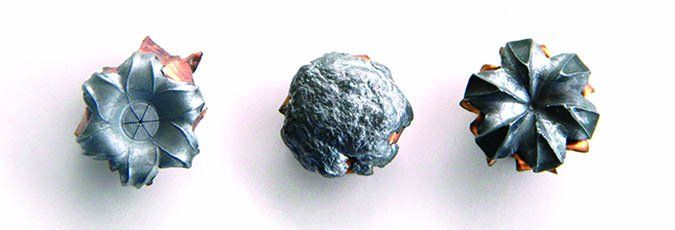
Next was the problem of the failures to fire. All our misfires had been with Cor-Bon ammo. We tried one round three times and it still didn’t fire, and its primer was unmarked. The other two types of test ammunition worked perfectly. Somewhat dumbfounded, we sent for a duplicate gun to see if it would work. While the solution seems to be to avoid the otherwise excellent and time-proven Cor-Bon ammo, who is to say another brand of ammunition might not do the exact same thing? The ultimate solution is to test, test, and retest your chosen self-defense ammo. And then do it again.
Still, “Our Team Said: We would not buy this gun. It was a disappointment to have so much trouble.”
So, with all that as a backdrop, here’s how these handguns fared in the here and now.
Remington R51 96430 9mm Luger, $400
GUN TESTS GRADE: D
The Remington is priced fairly, and it is accurate enough for personal defense. Some liked the racy lines of the R51. Performance was not impressive; it simply refused to function with one type of ammunition. The trigger was poor, in our opinion, with no discernible reset and some annoying side-to-side motion. We would not purchase this handgun.
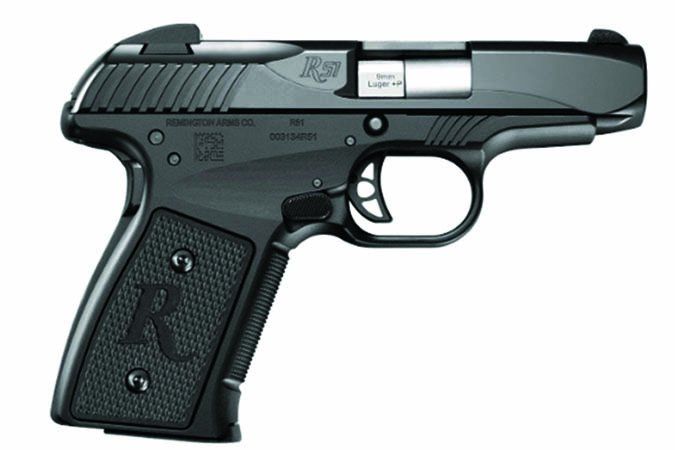
| ACTION | Semi-auto single action; Pederson block design |
| OVERALL LENGTH | 6.5 in. |
| OVERALL HEIGHT | 4.6 in. |
| MAX WIDTH | 1.1 in. |
| WEIGHT UNLOADED | 22.2 oz. |
| WEIGHT LOADED | 24.7 oz. |
| BARREL LENGTH | 3.4 in. |
| BARREL | Steel, +P rated; hard-chromed barrel bushing |
| MAGAZINE | (2) 7-rd. semi-flush |
| SLIDE | Steel; black FNC |
| FRAME | Aluminum alloy, black anodized finish |
| FRAME FRONT STRAP HEIGHT | 2.4 in. |
| FRAME BACK STRAP HEIGHT | 3 in. |
| GRIP | Checkered black polymer |
| GRIP THICKNESS (max) | 1 in. |
| GRIP CIRCUMFERENCE (max) | 5.4 in. |
| SIGHTS | Drift-adjustable rear; front post |
| TRIGGER PULL WEIGHT (SA) | 6.6 lbs., polymer |
| TRIGGER SPAN (SA) | 3.6 in. |
| SAFETY | Grip |
| WARRANTY | 2-year limited |
| WEBSITE | Remington.com |
| TELEPHONE | (800) 243-9700 |
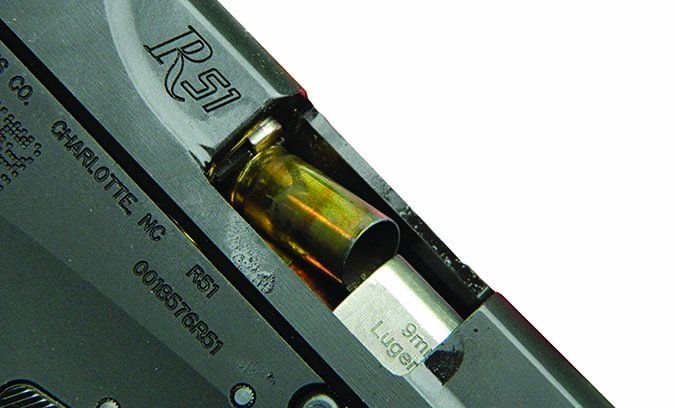
This was the asking price at Cabelas.com. The Remington R51 is billed as a modern version of the classic R51 380 ACP pistol, save in 9mm caliber. The SIG P938 is also an upsized and redesigned version of a 380 ACP handgun, the SIG P238. The Remington R51 was released a few years ago and then withdrawn due to several problems that affected function. As noted above, there are a number of changes to the handgun, and our goal was to forget about the previous problems and let the 2016 version stand on its own merits.
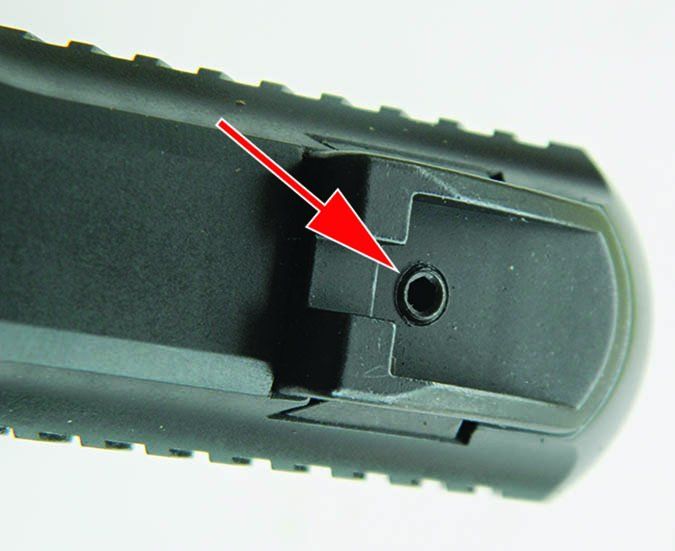
The pistol isn’t a locked-breech design like the other handguns tested and most other 9mm-caliber pistols. The barrel is in a fixed position held by the slide-stop pin and tenons that fit into mortises in the frame. The recoil spring is wound around the barrel, uncommon for a 9mm handgun, but standard operating procedure for many compact 380 ACP pistols. The barrel and slide ride lower in the frame with this design, which results in a lower bore axis. (The bore center line is close to the hand, limiting muzzle flip. There is simply less leverage for the recoiling gun to kick against and rise.) The pistol operates by retarded blowback action, similar in principle to the Heckler & Koch P7, but different in operation. Another similar handgun as far as operation is the Walther CCP. Instead of retarding slide action with a gas block, the Remington uses the breech block. When the R51 fires, the breech is locked, but only momentarily. Once the bullet exits the barrel and pressure abates, the cartridge case pushes the breech block, which is a separate part of the slide, to the rear. The breech block is stopped by a locking shoulder. The slide continues its rearward travel, and as the bullet exits the barrel, pressure drops, and then the slide cams the breech block out of its locked position. The two parts, breech block and slide, then move rearward together. The extractor pulls the spent case from the chamber and the spent cartridge case is ejected. The slide is pulled forward by the recoil spring and a fresh cartridge is loaded.
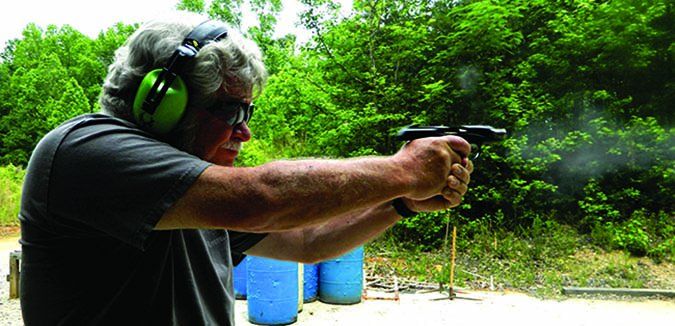
The pistol has no safety other than the grip safety. The grip safety engages both the sear and the firing-pin block or drop safety. There is a distinct click as the grip safety is depressed. Some raters referred to it more as a grating sound than a click. The pistol isn’t difficult to rack, but it was more difficult to rack and load than the other handguns due to the powerful recoil spring, a necessity for a pistol that doesn’t use locked-breech operation. All short-slide 9mm handguns must have a strong recoil spring for reliable operation, but the locked-breech design doesn’t require quite as heavy a recoil-spring weight.
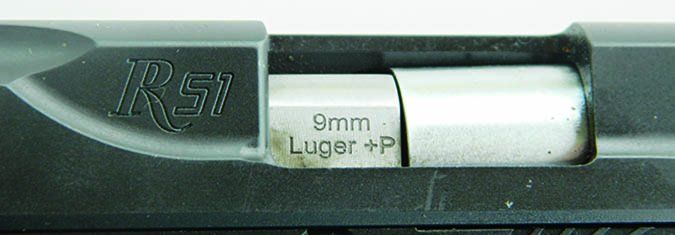
The trigger isn’t as tight was we would like, there is considerable lateral motion. The trigger broke consistently at 6.6 pounds, heavier than the version we tested some years ago. The slide is stainless with a dark Melonite coating. There is a visual loaded-chamber indicator cut into the top of the slide. The cocking grooves are adequate. The barrel fits the slide well, and the barrel is grooved for grasping during disassembly.
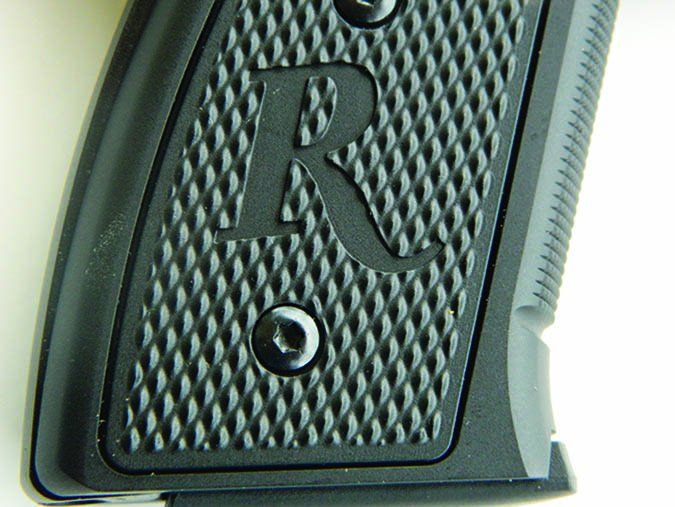
Disassembly is difficult. We feel first-time buyers attempting to field-strip and maintain the pistol will be frustrated. Our raters are experienced and one works as a gunsmith. Depressing the ejector as you replace the slide and watching a sagging breech block tries one’s patience. The pistol cannot be assembled, we found, unless held upside down. The pistol is field-stripped by removing the slide lock, moving the slide toward the rear, pulling the barrel forward to disengage the breech block, removing the slide, barrel and breechblock, and then reassembling the handgun. Be certain the slide lock fits properly, or the pistol will malfunction. We rated the pistol down a grade based on its reassembly difficulty.
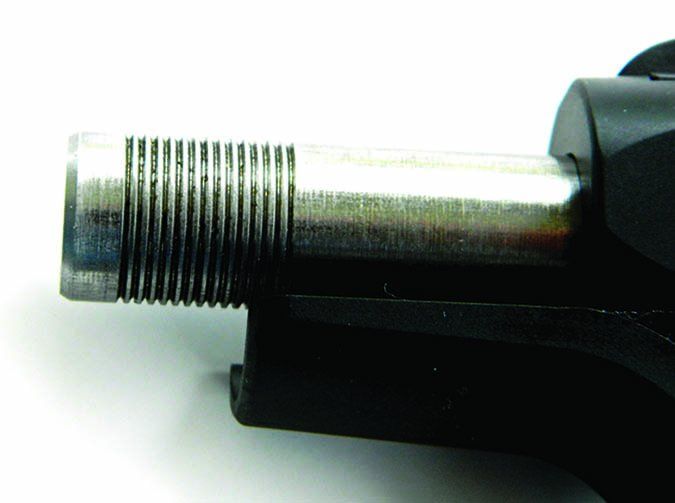
The frame is aluminum alloy. The checkering on the grip panels is adequate, and the backstrap has no checkering. The front strap is very nicely checkered, a good feature. There are slight depressions behind the trigger to improve finger reach. A cut-out under the trigger guard makes for a space that allows a firm grip and lowers the bore axis. The magazine release is ambidextrous. The steel magazines have a 7-round capacity. The three-dot white outline sights are credible sights for a handgun this size, but they are not exceptional, we believe. There is a flat spot on the rear sight for racking the slide on the belt if need be, similar in concept to the Honor Defense Honor Guard handgun sights in a pistol tested in an upcoming match up. The pistol was test fired with a total of five 9mm Luger loads, including the 115-grain Federal Syntech, Federal American Eagle 124-grain FMJs, the SIG Sauer 124-grain V-Crown, the Hornady 100-grain Critical Defense Lite, and the Hornady 124-grain XTP +P American Gunner. Some of the loads were used for combat firing only and others for accuracy. We wished to be certain the Remington and the other pistols were reliable with a range of ammunition. The R51 is marked to accept 9mm Luger +P, so we fired a magazine of the Hornady +P load in each pistol during the combat firing.
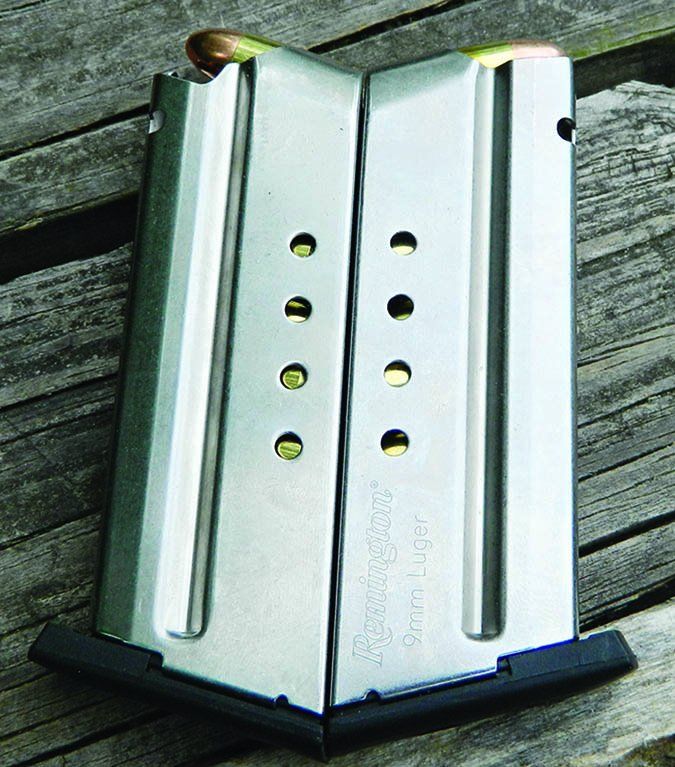
First up was the Federal Syntech 115-grain 9mm. We intended to fire 50 rounds in the combat firing course, firing at targets at 5, 7, and 10 yards. Although properly lubricated, the Remington refused to function. It choked on every round, with the spent case found in the ejection port. This wasn’t a good start. We switched to the Federal American Eagle 124-grain rounds and loaded the two supplied magazines. The pistol failed to function with two of six cartridges in the first magazine and then began to function. We were able to fire the combat test with the R51 using a string of 44 rounds of 9mm 124-grain Federal American Eagle without difficulty. After firing the 124-grain 9mm loads, we went back to the 115-grain Syntech, thinking that we had encountered a break-in malfunction. The R51 would not function with the 115-grain 9mm load at all. As a result of this testing, the Remington was fired more than the other pistols during the tactical firing tests. Reliability certainly is a concern. We rated the pistol down a full grade on these failures. A break-in period is acceptable, but the other pistols did not experience these break-in problems, and the pistol refused to function with a load that the other handguns ran with. The SIG did fail to lock on the last shot when new on several occasions, but that was not as big of a problem as the Remington’s troubles.
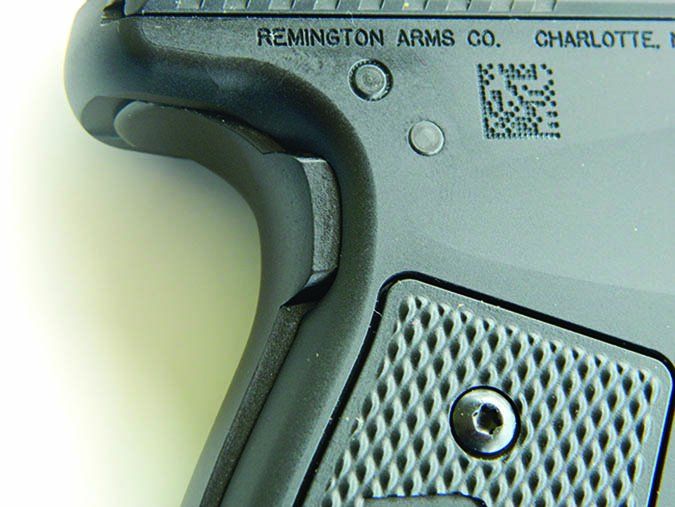
When firing off hand for combat groups, the pistol was controllable. The long slide, low bore axis, and long grip with a finger-extension magazine made for good control. The trigger has no detectable reset. After firing, the trigger cannot be ridden forward to reset with the finger on the trigger as some designs may be. The finger must completely release the trigger, and even then there is no click or discernible rest, other than the trigger becoming tight after it resets. Combined with the play in the trigger, we rated the Remington down a full grade based on the poor trigger action.
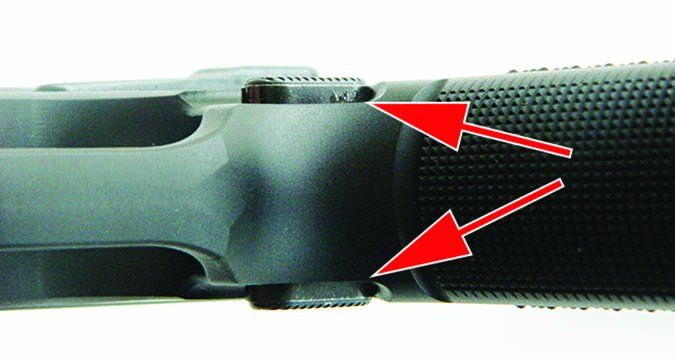
When fired at combat targets, the pistol gave good results despite the trigger, centering the hits at 10 yards. Sometimes the group was off center, which one rater blamed on “trigger wobble,” the side-to-side play we mentioned previously. The R51 was reliable and comfortable to fire with the Hornady +P loading. It was behind the SIG and the Taurus but ahead of the Kel-Tec in combat firing. Moving to firing for accuracy, we shot the Hornady Lite load, the SIG Sauer V-Crown JHP, and the Federal American Eagle 124-grain loading. The Remington functioned with all three loads, even the low-impulse Hornady Lite load, intended as a low-recoil personal-defense round. Accuracy was good, with the best showing coming with the V-Crown, 2.0 inches at 15 yards.
Our Team Said: The R51 pistol is accurate enough and functioned well with some, but not all, loads. The power factor of the Syntech load was higher than the Hornady Lite, yet the R51 refused to run the Federal Syntech 115-grain load, which all the other handguns fed, chambered, fired, and ejected. Also, the R51 was the hardest pistol to rack, had a difficult field strip, and a poor trigger action. We would not buy this handgun.
SIG Sauer P938 Engraved Rosewood Micro-Compact 938-9-ESR 9mm Luger, $730
GUN TESTS GRADE: B
Failures to fire and failures to lock the slide open on the last shot disappeared with full-power defensive loads. The pistol had enough break-in glitches to be rated down a full grade. Nonetheless, the SIG P938 is attractive and desirable. The P938 is compact, but easy enough to fire well. The slim grip is ideal for concealed carry. We really like the trigger; it is the best of the test. The SIG demonstrated excellent practical accuracy and also good absolute accuracy.
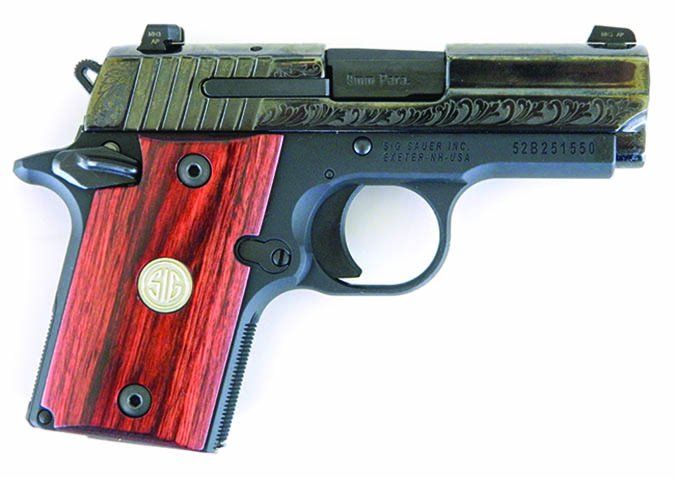
| ACTION | Semi-auto single action |
| OVERALL LENGTH | 6 in. |
| OVERALL HEIGHT | 3.9 in. |
| MAX WIDTH | 1.2 in. |
| WEIGHT UNLOADED | 16 oz. |
| WEIGHT LOADED | 18.5 oz. |
| BARREL LENGTH | 3 in. |
| BARREL | Steel |
| MAGAZINE | (1) 6-rd. |
| SLIDE | Stainless steel; Nitron finish, polished and engraved |
| FRAME | Aluminum alloy; Micro Compact; hard coat anodized |
| FRAME FRONT STRAP HEIGHT | 1.6 in. |
| FRAME BACK STRAP HEIGHT | 2.2 in. |
| GRIP | Hogue rosewood; medallion inlay |
| GRIP THICKNESS (max) | 1.2 in. |
| GRIP CIRCUMFERENCE (max) | 5 in. |
| SIGHTS | Siglite night sights |
| TRIGGER PULL WEIGHT (SA) | 5.25 lbs. |
| TRIGGER SPAN (SA) | 2.8 lbs. |
| SAFETY | Dual ambidextrous lever |
| WARRANTY | Lifetime |
| WEBSITE | SIGSauer.com |
| TELEPHONE | (603) 610-3000 |
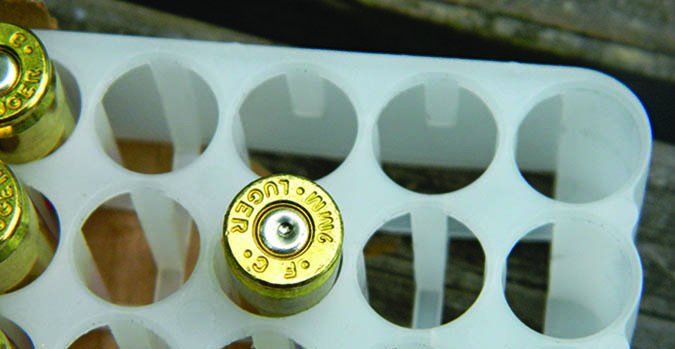
This was our price at ImpactGuns.com. This pistol’s features made it the flashiest pistol tested and also the most expensive. The nicely blued slide, the engraved section of the slide, the rosewood grips, and night sights really set this piece apart. As the R51 is a 9mm version of a 380 ACP pistol and the SIG P938 is also a 9mm version of a 380 ACP handgun, in this case the SIG P238, it’s worth noting that the makers cannot simply re-chamber the barrel and be good to go. The frame had to be enlarged and other important modifications to the design performed. They are different guns, but the appearance of the P938 is very similar to the P238 pistol. These handguns are more correctly termed “1911-like” than 1911s because the design differs from the 1911 template. They are more similar to the Star FireStar pistols in design. As an example, the FireStar 9mm, and particularly the earlier Star PD 45 ACP, had a well-deserved reputation for excess wear and battering. The SIG, however, uses a recoil spring and guide with a flat coil spring and a cup at the end of the spring. This prevents the battering present in earlier designs of the same type from different makers. It was recommended the Star guide rod assembly be replaced every 500 rounds. The SIG should go much longer.
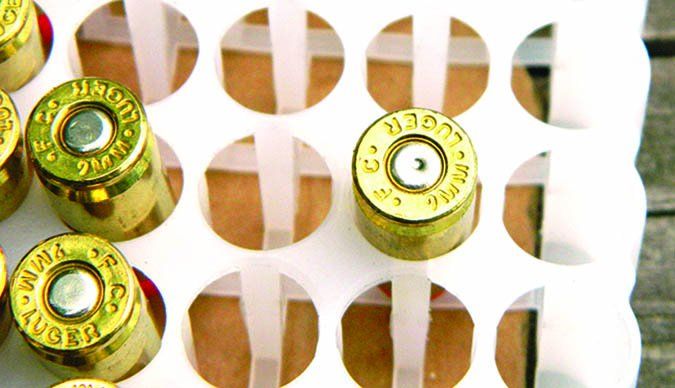
The SIG P938 features a locked-breech design. The P938 is a single-action pistol with an alloy frame. We like the short slide and found the grip only looks abbreviated; it is short in perspective to the relatively long slide. It is length wise no larger than most other slim-line 9mm pistols; it simply looks fat and short because of the short grip and long slide. The magazine holds 6 rounds. Only the Remington was supplied with a spare magazine, and we suffered through the evaluation with one magazine in each of the other handguns. Most raters could get a full firing grip, some, with larger hands, found the small finger hanging. The safety is positive in operation with a strong detent and is ambidextrous. The safety operates in a different manner than a true 1911. When the safety is applied, it does not block the slide’s movement. The pistol may be loaded with the safety on. The safety also may be applied with the hammer down, which we think has little practical application. The pistol may be carried cocked and locked, hammer to the rear or hammer down, with a loaded chamber. The trigger has some spongy take up and over travel but breaks at 5.25 pounds. This is lighter than a different version of the P938 we previously tested.
The slide is designed for a SIG P-series like appearance, with the slide featuring steps from the ejection port forward. The ejection port is large enough to allow for administrative handling with 9mm ammunition. The slide is very nicely finished in bright blue. The version tested features nicely done laser engraving. We liked the appearance. The sights are good example of combat sights. These are self-luminous iron sights. The tritium inserts were appreciated, and the sight picture excellent.
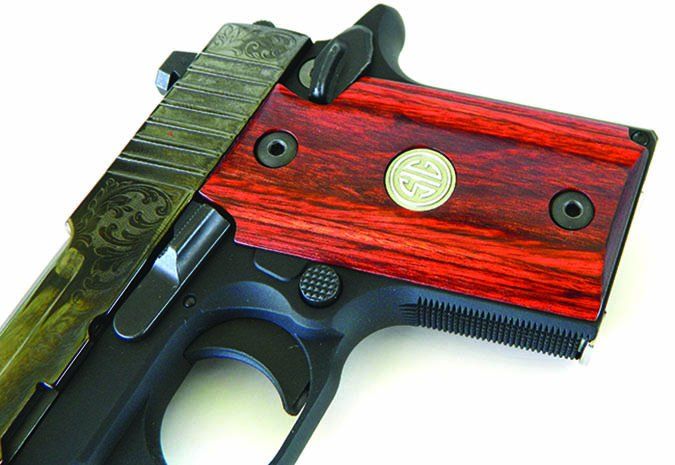
The frame is blue anodized. The smooth grips are well finished. The front strap is checkered in a very neat pattern that offers excellent abrasion in combination with the rear strap checkering at the base of the rear strap. Close examination shows other good features, including a top cartridge stabilizer at the bottom of the slide that keeps the top round in the magazine from moving under recoil. Also, the barrel is butted into the slide in SIG fashion for lockup, and it unlocks by angled camming surfaces, very un-1911 like. It works well and works better, in our opinion, than a swinging link would in this size handgun. The pistol isn’t difficult to field strip and reassemble. The 6-round magazine is high quality and isn’t difficult to load.
Compact 9mm handguns have to be handled with a proper grip, and that is a very tight grip with no pressure on the slide. For those who practice, the small-frame firearms may produce good accuracy. For those who become sloppy and crowd their hands onto the slide, the pistol will malfunction due to pressure on the slide and you will also miss the target. With that in mind, we began our evaluation of the SIG P938. When firing 50 rounds during the combat course, the pistol proved easy enough to rack. Recoil was not excessive. The pistol gave the best showing on the combat course, although the Remington R51 and the Taurus Slim were not far behind.
Then the SIG P938 suffered problems that may not be related to the handgun. In one instance the hammer fell and the cartridge did not fire. We ejected the cartridge and found a light primer strike. This seemed to be a gun-related failure, but we remembered similar problems in the previous test. Then, toward the end of the test, we experienced another problem, and this time, when the cartridge was removed from the chamber, the primer had taken a solid whack from the firing pin. This isn’t easily explained, having one light primer strike, which appears gun related, and another problem that is obviously ammunition related. But this did not occur with any other handgun and the Federal loads.
While this marred the combat firing stage to an extent, the SIG P938 turned in excellent results overall. However, the slide did not lock open on the last shot on several occasions with the practice FMJ loads. With heavier personal-defense loads, the slide never failed to lock open. In the accuracy tests, the best results were smaller than the Remington R51’s, another accurate handgun, and superior to the other handguns.
Our Team Said: The SIG P938 gave excellent results with the full-power defense loads. The failure to lock open on the last shot that occurred occasionally and the light primer strike were taken into account and the pistol rated down a grade. Also, this is an expensive pistol, and though it is a handsome handgun, a pistol this expensive should be supplied with a spare magazine. We rated it down another half grade on this count. A plus is that the pistol is supplied with a plastic range-grade holster.
Kel-Tec PF-9 9mm Luger, $257
GUN TESTS GRADE: A-
The Kel-Tec PF-9 9mm isn’t expensive, but it still costs about $60 more than the Taurus Slim. While the Taurus outshot the Kel-Tec, that doesn’t mean the Kel-Tec is out of the running for many shooters. This is a slim and trim handgun. The PF-9 comes closer to fitting in a pocket than the other handguns tested, and its double-action-only trigger provides a margin of safety when carried in a pocket. The PF-9 never failed to feed, chamber, fire, or eject. It is accurate enough for close-range defense. We would buy this handgun.
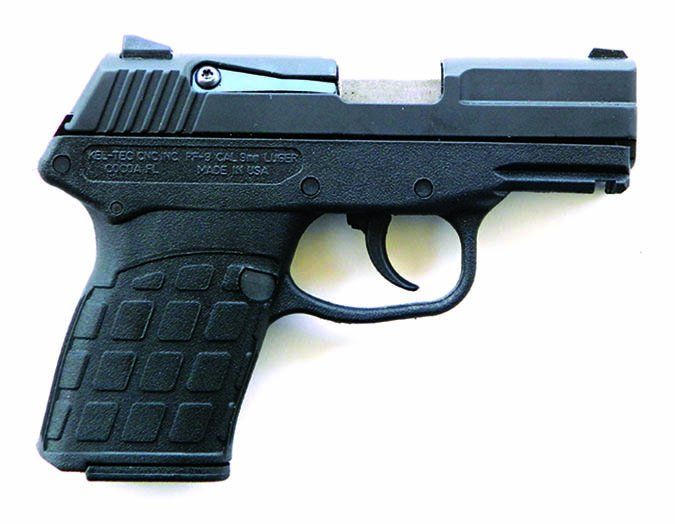
| ACTION | Semi-auto double-action only; recoil operated, locked breech |
| OVERALL LENGTH | 5.85 in. |
| OVERALL HEIGHT | 4.4 in. |
| MAX WIDTH | 0.9 in. |
| WEIGHT UNLOADED | 14.6 oz. |
| WEIGHT LOADED | 17.1 oz. |
| BARREL LENGTH | 3.1 in. |
| BARREL | Steel |
| MAGAZINE | (1) 17-rd. detachable box |
| SLIDE | Steel |
| FRAME | Aluminum |
| FRAME FRONT STRAP HEIGHT | 1.7 in. |
| FRAME BACK STRAP HEIGHT | 2.6 in. |
| GRIP | Black checked polymer |
| GRIP THICKNESS (max) | 1 in. |
| GRIP CIRCUMFERENCE (max) | 5 in. |
| SIGHTS | Fixed |
| TRIGGER PULL WEIGHT (SA) | 6.5 lbs. |
| TRIGGER SPAN (SA) | 3.3 in. |
| SAFETY | None |
| WARRANTY | Lifetime to original owner |
| WEBSITE | KeltecWeapons.com |
| TELEPHONE | (321) 631-0068 |
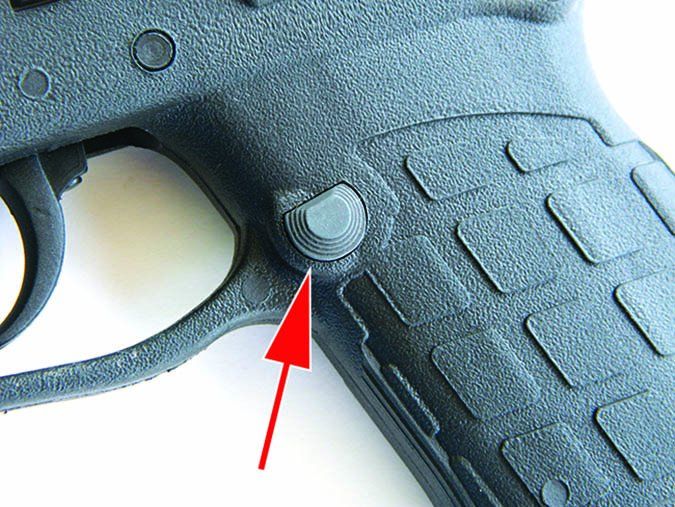
At $257 (from BudsGunShop.com), the PF-9 is much less expensive than the Remington, and you could purchase two PF-9s and the Taurus Slim for the price of the SIG. The Kel-Tec PF-9 was among the first, if not the first, slim-line ultralight 9mm handguns. The pistol features a polymer frame and double-action only trigger. The trigger was tight, and while some of the raters commented it felt heavier, it broke at 6.5 pounds. This isn’t a striker-fired handgun, but the PF-9 uses a hammer. The unloaded weight is a light 12.5 ounces. The pistol is 5.25 inches long and width is 0.9 inch. The PF-9 is small but has an advantage in its 7-round magazine, versus the 6-round magazine of the P938, as an example. When you compare the pistol to the 8.5-ounce P3-AT 380 ACP from the same maker, which has an overall length of 5.2 inches as well, the PF-9 offers considerable advantages with very little extra girth. The big difference is in power.
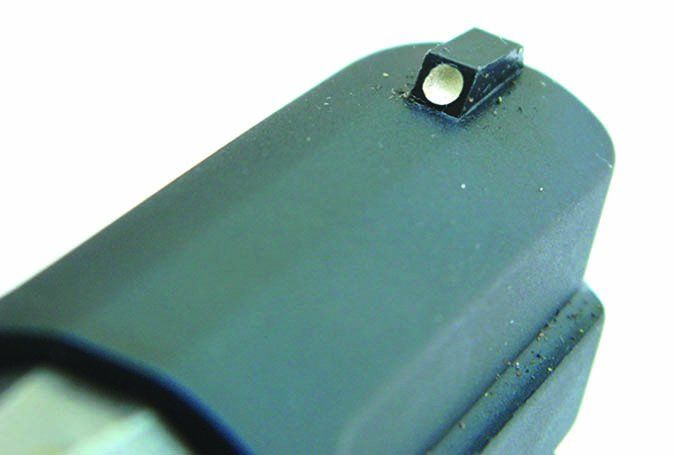
The 9mm Luger has benefitted a great deal from ammunition and projectile development, and the PF-9 might look better today than when first introduced due to this improvement. The pistol is conventional for a polymer-frame gun. The grip treatment offers good abrasion and adhesion. Compared to the nearest price leader, the Taurus Slim, we preferred the Kel-Tec treatment. The grip was small however. The sights are adequate and the slide is slim and easily holstered. The double-action trigger is smooth enough with a rapid reset. The ejection port is large enough for administrative handling.
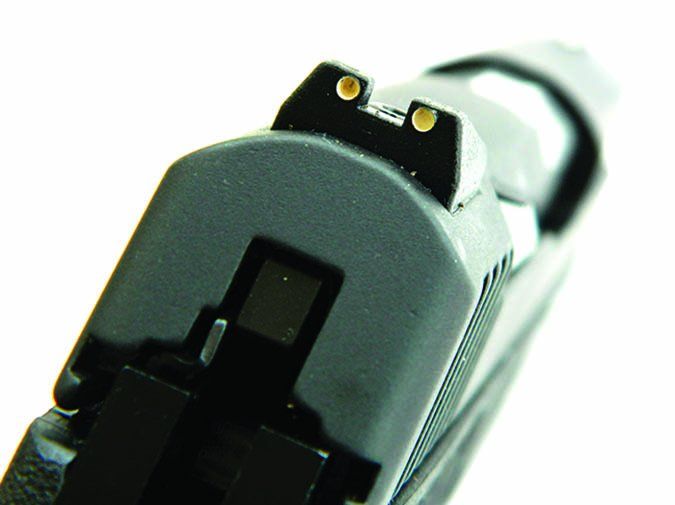
Firing the DAO trigger is much different than addressing a single-action trigger. The movement to the rear and to the front after reset demand coordination. The pistol is fired and the trigger is given time for reset. We try to do each handgun test independently and come back and compare notes, however, when just firing one trigger action or the other and then moving to another handgun, the differences in trigger actions are very noticeable. The DAO Kel-Tec is smooth enough but not comparable in control to the single-action triggers of the other handguns. The sights are adequate for a true pocket handgun. There is no manual safety; the DAO trigger is the safety feature. The locked breech action is conventional. The takedown isn’t as easy the Taurus Slim, but it nowhere near as difficult as the Remington.
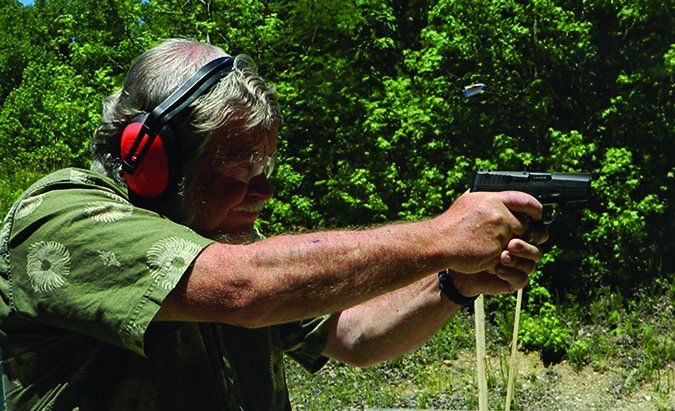
To get started at the range, the pistol was lubricated and the magazines loaded with Federal Syntech 115-grain ammunition. Half of the test was done with this load and half with the American Eagle 124-grain 9mm, for 50 rounds fired. The pistol fired the 50 rounds without a single failure to feed, chamber, fire, or eject, something that was not true of the more expensive Remington R51 and the SIG P938, regardless of the causes. There were no failures of the pistol to cycle or of the slide to lock back. As a caution, however, be certain the hands do not ride the slide with this pistol. It is easy to do with the short-slide 9mm and that factor is a common cause of malfunctions of pistols this size. During the combat course, the PF-9 gave a good account of itself, and while the groups were not as tightly centered as the other pistols, they were adequate for personal defense, with none straying from the high-scoring zones.
Just the same, this handgun is more difficult to control than the heavier pistols, which is to be expected. Inexperienced shooters might find it difficult to control. The single magazine of +P loads were not markedly more difficult to control in the PF-9 because we were already gorilla-gripping the pistol. During accuracy testing from the bench rest position, the Kel-Tec PF-9 was fired with two personal-defense loads and a single FMJ loading. The pistol has more recoil than the others tested. This keeps bringing us back to the light weight of the PF-9. The DAO trigger is long, but smooth, and demanded our attention in firing. The Kel-Tec PF-9 gave reasonable results, with the single-best group with the 124-grain Hornady V-Crown coming in at 3.0 inches at 15 yards. Most groups were larger, with the majority running over 4 inches.
Our Team Said: The pistol never malfunctioned and gave a credible showing. It is a true 9mm pocket pistol. We rated the PF-9 down a half-grade based on accuracy. Just the same, this is a desirable defensive handgun and a good buy. The Kel-Tec has a rail mount for a combat light as well, but many of the lights we had on hand were not practical with the short rail.
Taurus 709 Slim 1-709031FS 9mm Luger, $198
GUN TESTS GRADE: A (Best buy)
The Taurus Slim 9mm is reliable. We would buy this gun, and based on its performance, we would carry it for personal defense. That is where the score cards led us.
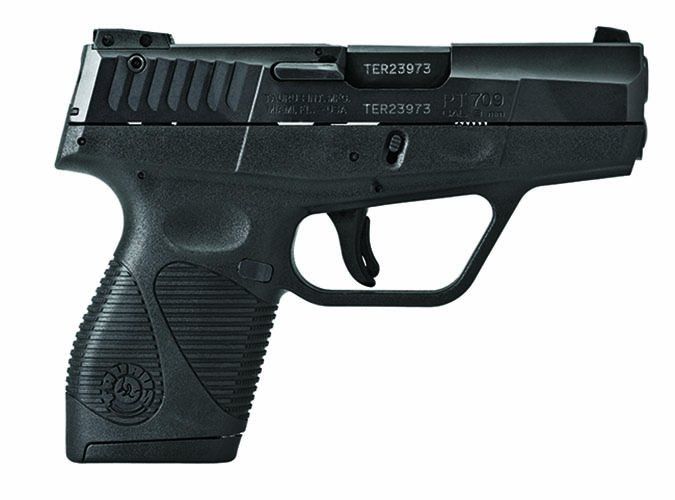
| ACTION | Semi-auto single action; first-shot double action |
| OVERALL LENGTH | 6 in. |
| OVERALL HEIGHT | 4.5 in. |
| MAX WIDTH | 0.9 in. |
| WEIGHT UNLOADED | 16.8 in. |
| WEIGHT LOADED | 20 oz. |
| BARREL LENGTH | 3 in. |
| BARREL | Steel |
| MAGAZINE | 7-rd. detachable box |
| SLIDE | Steel |
| FRAME | Black polymer, compact |
| FRAME FRONT STRAP HEIGHT | 1.8 in. |
| FRAME BACK STRAP HEIGHT | 2.8 in. |
| GRIP | Black polymer |
| GRIP THICKNESS (max) | 1 in. |
| GRIP CIRCUMFERENCE (max) | 5.35 in. |
| SIGHTS | Adjustable rear, fixed blade front |
| TRIGGER PULL WEIGHT (SA) | 5.2 lbs. |
| TRIGGER SPAN (SA) | 2.6 in. |
| SAFETY | Slide-mounted lever; trigger |
| WARRANTY | Lifetime |
| WEBSITE | TaurusUSA.com |
| TELEPHONE | (800) 327-3776 |
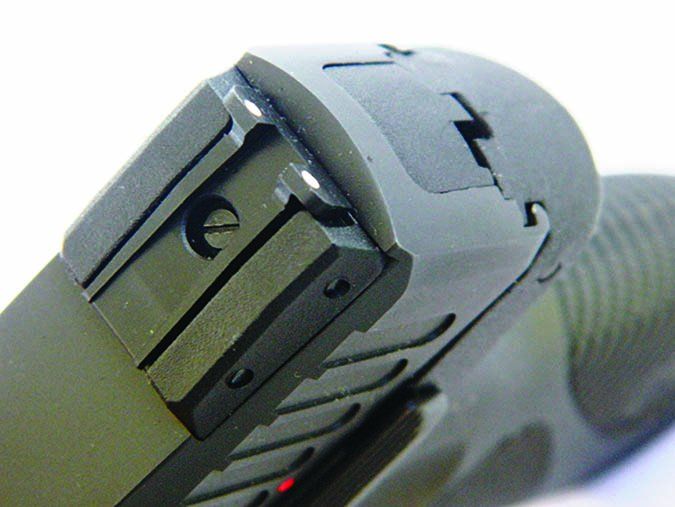
This was our price from CheaperThanDirt.com. The Taurus Slim is the least expensive handgun tested. It is supplied with a single magazine, which is understandable at this price level. The pistol is 6.25 inches long and 4.5 inches high. Slim is a fitting nickname. The Taurus 9mm weighs 19 ounces, less than the two more expensive handguns but 7 more ounces than the Kel-Tec. The sights are adequate for a concealed-carry handgun, and they were also easily lined up and picked up due to the three-dot set up.
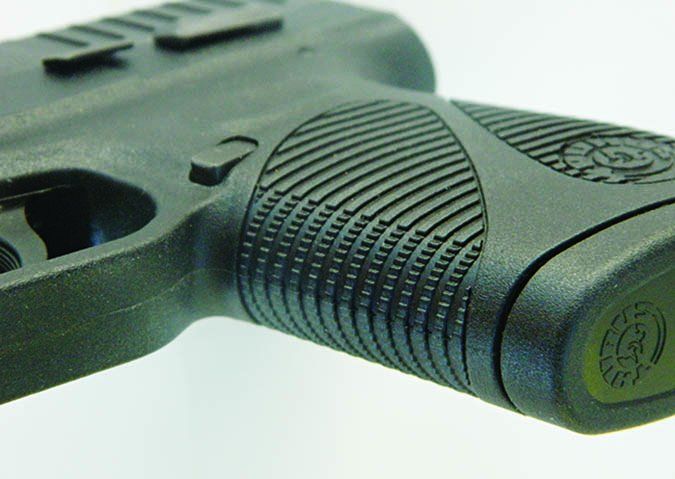
The ribbed treatment of the grip offers an excellent hold. The cocking grooves in the slide are well designed, and the pistol was rated the easiest of the four pistols to rack. The magazine holds 7 rounds. The slide lock, magazine release, and manual safety were positive in operation. The loaded-chamber indicator in the top of the chamber is a good touch. The fit and finish of the pistol are good, better than expected for the price. The trigger action is single action, although it is often referred to as a double action. The trigger breaks cleanly at 5.2 pounds. The feel of the trigger is difficult to explain. When the slide is racked, the pistol is cocked and the trigger breaks at 5.2 pounds, simple enough. But there is a long take up with some resistance, or at least movement felt, and then the trigger races to a stop and breaks abruptly. It is superior to the Remington, a more conventional trigger, but demands acclimation. It took some dry fire and a bit of firing before we felt we were in control of the trigger.
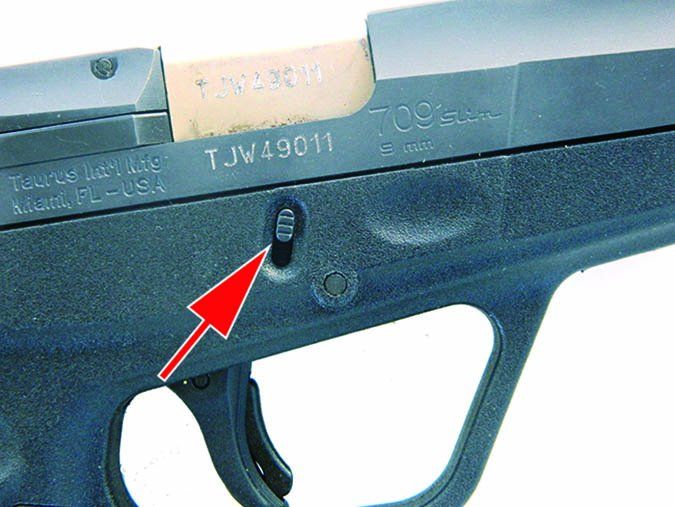
It isn’t recommended that this handgun ever be carried without the manual safety engaged. It is, after all, a single action, and it would be the same as carrying a 1911 handgun cocked and unlocked. There is another facet to the trigger action. Once the trigger is fired, and the slide isn’t racked by firing or in dry fire to cock the hammer, the trigger may be pressed again and a longer double-action press will fire the handgun. This second strike feature breaks at 5.75 pounds. This feature doesn’t hurt anything and offers a re-strike in case of a faulty cartridge. Had we been able to invest more time in the trigger, we feel combat accuracy may have been better. As it stands, accuracy was overall pretty good.
During the combat course, we used a combination of the two Federal Cartridge Company FMJ loads at 5, 7, and 10 yards. In combat shooting, the pistol was comparable to the Remington but with slightly better results due to the good trigger action. The SIG bested the Taurus in rapid fire by a margin. The difficulty in properly engaging the Taurus trigger was the reason the SIG bested the Slim, we felt. The Taurus ran through the combat course without any type of malfunction.
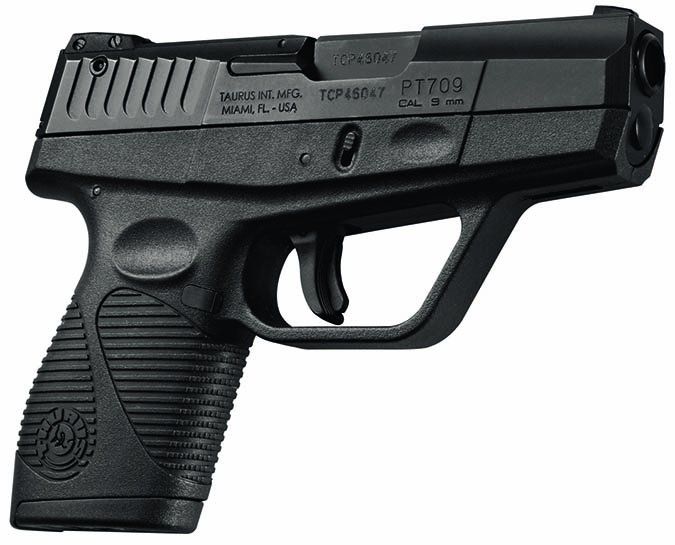
In the accuracy sequence of the test, we fired the same three loads used in the other handguns. The Taurus generated the greatest velocity and energy of the four pistols tested. We were particularly impressed that the SIG Sauer 124-grain V-Crown, a standard-pressure load, exhibited 1142 fps from a 3-inch barrel. The pistol wasn’t as accurate as the Remington or the SIG with two of three loads, while exhibiting excellent accuracy with the light-recoiling Hornady 100-grain load. The Taurus Slim finished the test with no malfunctions and credible performance.
Our Team Said: As we neared the end of the test, the score card began to favor the Taurus. Reliability was equaled by the Kel-Tec PF-9, but the Taurus Slim gave better results on the combat course and in absolute accuracy. Takedown was easier. The Taurus also cost less than the Kel-Tec. The absolute accuracy results were better than the Kel-Tec, and the difference between the Taurus and the other two handguns was mostly conversational in value. In short, the pistol gave good performance not only in its price range but also compared to much more expensive handguns. The Taurus 709 Slim 9mm is the best buy of this test.
Written and photographed by Bob Campbell, using evaluations from Gun Tests team testers.
















